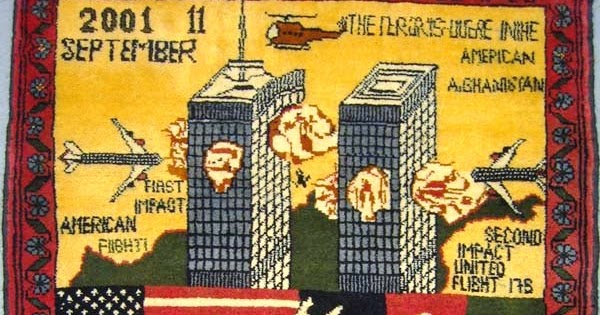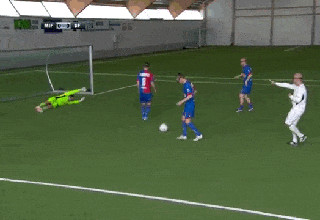
Twitter user @RespectableLawyer walks us through the origins of the rugs, which date back to the Soviet occupation of Aghanistan from 1979-1989, and how they turned into war souvenirs for U.S. Soldiers after the invasion of Afghanistan.
THREAD: Afghan War Rugs and the Lossy Compression of Cultural Coding pic.twitter.com/LuJpU5RccN
— Respectable Lawyer (@RespectableLaw) May 3, 2018
1) The “war rug” tradition of Afghanistan has its origins in the decade of Soviet occupation of Afghanistan from 1979 - 1989. pic.twitter.com/a385VdsZQq
— Respectable Lawyer (@RespectableLaw) May 3, 2018
2) Afghan rug-makers began incorporating war equipment into their designs almost immediately after the Soviet Union invaded their country. pic.twitter.com/eyo9fUPkGD
— Respectable Lawyer (@RespectableLaw) May 3, 2018
3) War rugs had a resurgence when the U.S invaded Afghanistan in 2002. The most famous example is shown below. pic.twitter.com/Xvo3wIzAUA
— Respectable Lawyer (@RespectableLaw) May 3, 2018
4) In the modern version of the war rug, the image was created on something like MS Paint, and then a template provided to a weaver.
— Respectable Lawyer (@RespectableLaw) May 3, 2018
5) The weaver then worked by hand, pixel by pixel as it were, meaning that every war rug is unique.
— Respectable Lawyer (@RespectableLaw) May 3, 2018
6) For example, here is another version with subtle differences. These rugs were sold as souvenirs to American military personnel. pic.twitter.com/MwWor77nZ2
— Respectable Lawyer (@RespectableLaw) May 3, 2018
7) Icons in these war rugs are lifted directly from US PsyOp leaflets. For example, the flag/dove symbol comes from this leaflet: pic.twitter.com/a92BG9BkO8
— Respectable Lawyer (@RespectableLaw) May 3, 2018
8) The iconography does not always translate well. Some Afghans believed the symbol to be some type of chicken.
— Respectable Lawyer (@RespectableLaw) May 3, 2018
9) They assumed that the leaflet could be used as a coupon that entitled them to a free bird or meal provided by the Coalition.
— Respectable Lawyer (@RespectableLaw) May 3, 2018
10) Manual reproduction of rugs means they are copied from another, over and over. Images change, are simplified, and morph into new forms.
— Respectable Lawyer (@RespectableLaw) May 3, 2018
11) For example, weavers still target Russian customers, such as this example which is not a depiction of the Avengers on a tank. pic.twitter.com/6AUI8vZQVG
— Respectable Lawyer (@RespectableLaw) May 3, 2018
12) The rug depicts a famous Russian monument. pic.twitter.com/fD2yWt5C8d
— Respectable Lawyer (@RespectableLaw) May 3, 2018
13) But did you notice that weird design in the bottom panel? pic.twitter.com/G33FzSEB2z
— Respectable Lawyer (@RespectableLaw) May 3, 2018
14) It’s actually a reworked version of the aircraft carrier deck in this 9/11 rug. pic.twitter.com/4xoDVDQGt6
— Respectable Lawyer (@RespectableLaw) May 3, 2018
15) The carrier super-structure has morphed into some kind of bird design. pic.twitter.com/8sqvFA3y2v
— Respectable Lawyer (@RespectableLaw) May 3, 2018
16) Images morph not just from rug to rug, but even in a single rug design.
— Respectable Lawyer (@RespectableLaw) May 3, 2018
17) The weavers (often children) who make the 20th (or 100th) copy have no idea of the meaning of the iconography they are reproducing.
— Respectable Lawyer (@RespectableLaw) May 3, 2018
18) As a result, the original 9/11 rug has slowly turned into rugs like this: pic.twitter.com/zo69QxQ0do
— Respectable Lawyer (@RespectableLaw) May 3, 2018
19) Generations of reproduction produced by copying from previous copies results in an almost incomprehensible outcome.
— Respectable Lawyer (@RespectableLaw) May 3, 2018
20) Like a jpeg that has been repeatedly compressed, the image begins to lose its original coherence. pic.twitter.com/U195zZmQpM
— Respectable Lawyer (@RespectableLaw) May 3, 2018
21) War rugs straddle a weird line between fine art and souvenir curio.
— Respectable Lawyer (@RespectableLaw) May 3, 2018
22) To me, the gulf between their iconography’s meaning and the production of the art is its most intriguing feature.
— Respectable Lawyer (@RespectableLaw) May 3, 2018
23) And strangely enough, they have more artistic gravity than the kinds of art Americans made for themselves to mark 9/11. pic.twitter.com/Lbq0qI7agr
— Respectable Lawyer (@RespectableLaw) May 3, 2018
24) If you’re interested in learning about these bizarre artifacts, go check outhttps://t.co/sIAIHgPbfR
— Respectable Lawyer (@RespectableLaw) May 3, 2018






1 Comments